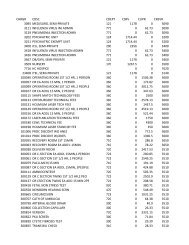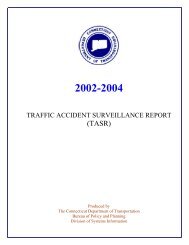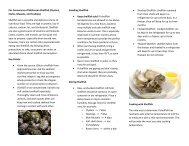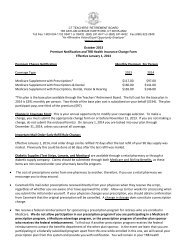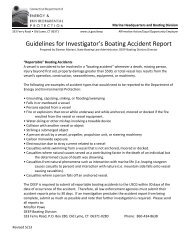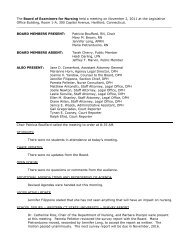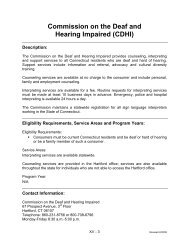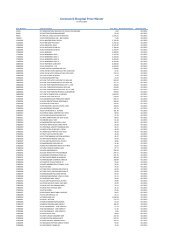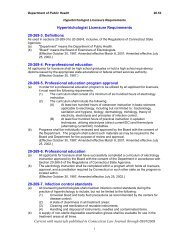Public Act 490 Guide - CT.gov
Public Act 490 Guide - CT.gov
Public Act 490 Guide - CT.gov
You also want an ePaper? Increase the reach of your titles
YUMPU automatically turns print PDFs into web optimized ePapers that Google loves.
RECOMMENDED PA <strong>490</strong> LAND VALUES<br />
PA<br />
<strong>490</strong><br />
SE<strong>CT</strong>ION 4: RECOMMENDED PA <strong>490</strong> LAND VALUES<br />
CGS Section 12-63 Rule of Valuation states that: The<br />
present true and actual value of land classified as farmland<br />
pursuant to Section 12-107c, as forest land pursuant to<br />
Section 12-107d, as open space pursuant to Section 12-107e<br />
or as maritime heritage land pursuant to Section 12-107g,<br />
shall be based upon its current use without regard to neighborhood<br />
land use of a more intensive nature.<br />
What this means is that classified land will not be<br />
assessed at the higher fair market value but at a lower<br />
land use value. This has been affirmed by the courts:<br />
Rustici v. Town of Stonington 1977 and Bussa v. Town of<br />
Glastonbury 1968.<br />
CGS Chapter 201 Section 12-2b provides that the<br />
Office of Policy and Management in consultation<br />
with the Commissioner of Agriculture shall develop a<br />
recommended schedule of land use values for PA <strong>490</strong><br />
valuation. These values are required to be updated<br />
every five years. These recommended values are<br />
made available to each municipality and to the<br />
general public.<br />
It is strongly urged that towns use these values.<br />
However, a municipality may choose not to use these<br />
recommended values. If this occurs, the values used<br />
by that town for each classified property must be<br />
supported by data and an approved methodology.<br />
Values other than those recommended by the<br />
Office of Policy and Management must be justified<br />
in the context of CGS Chapter 203 Section 12-63:<br />
Rule of valuation.<br />
METHODOLOGY USED TO OBTAIN<br />
RECOMMENDED PA <strong>490</strong> FARMLAND<br />
USE VALUES<br />
The development of the <strong>Public</strong> <strong>Act</strong> <strong>490</strong> 2010 Land Use<br />
Values, based on the capitalization of rent, was initiated in<br />
June of 2009 by the Connecticut Farm Bureau Association<br />
in cooperation with the Connecticut Department of<br />
Agriculture, and the PA <strong>490</strong> <strong>Guide</strong> Advisory Committee<br />
that redesigned the Net Rental Land Use Value Survey<br />
(See Appendix C). This tool proved quite successful as the<br />
information received was more reliable, and much easier<br />
to understand and interpret than in the past 2000 and<br />
1995 surveys. More than 1,500 surveys were distributed<br />
using mailing lists compiled by Connecticut Farm Bureau<br />
Association and the Connecticut Department of Agriculture.<br />
The survey also was distributed at various agricultural<br />
meetings and venues and through personal contact by<br />
Farm Credit East, the Connecticut Department of Agriculture,<br />
Connecticut Farm Bureau, Farm Service Agency, and<br />
the Natural Resources Conservation Service. The importance<br />
of returning the survey was emphasized, and 129<br />
individual farmers and property owners returned surveys<br />
representing 361 individual rent values (332 were used,<br />
equaling 89%). The 2009 survey provided more usable<br />
data compared to the 2000 survey, which included 742<br />
rents (635 were used, equaling 85%). The total number of<br />
submitters in 2000 was not counted.<br />
An overview of the data indicates a significant increase<br />
in the dollar per acre rents for Tillable A and Tillable B<br />
farmland, particularly river valley land. There are two<br />
reasons for this increase. One, the rent information has<br />
not been collected for ten years, and two, the continued<br />
decline in the amount of quality valley farmland available<br />
with fewer, but much larger and dominant farms. Farmers<br />
are competing for this land not only through rental agreements,<br />
but as evident in the marketplace. The demand is<br />
a combination of a very strong residual tobacco industry,<br />
coupled with a strong demand for valley land for fruits<br />
and vegetables.<br />
For the less productive Tillable C and D land, the competition<br />
is varied. There are a number of large dairy farms<br />
with over 500 cows. Only a small number of these farms<br />
submitted rental information, believed to indicate the<br />
significance of competition for rental lands. The other<br />
significant factor is the percentage increase in the amount<br />
of land that is being rented for no cash consideration.<br />
In 2000, the total percentage of rent values submitted as<br />
zero was 15% and in 2010 it was 37%. This also indicates<br />
there is more Tillable C, Tillable D and pasture land in the<br />
hands of non-farmers who want to keep their land open<br />
by allowing farmers to use their land for no fee. A few<br />
landowners were receiving non-cash consideration from<br />
4<br />
<strong>Public</strong> <strong>Act</strong> <strong>490</strong>: A Practical <strong>Guide</strong> and Overview • http://www.cfba.org/pa<strong>490</strong>guide.htm • Connecticut Farm Bureau Association




